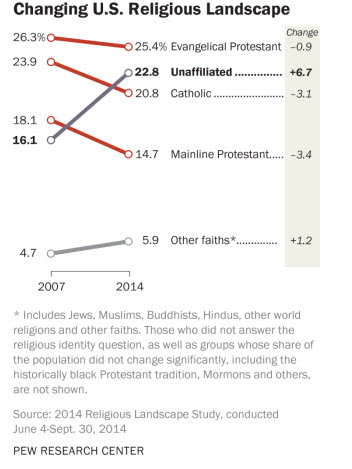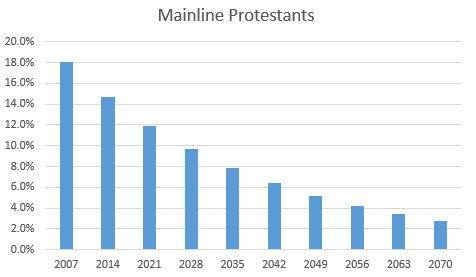 In 2007 the Pew Research Center conducted their initial U.S. Religious Landscape Study. The 2014 edition, published earlier today, shows Christianity declined by 8% in America over the last seven years (78.4% to 70.6%). Allowing for the margin of error, this means the number of Christian adults in the U.S. has shrunk by somewhere between 2.8 million and 7.8 million.
In 2007 the Pew Research Center conducted their initial U.S. Religious Landscape Study. The 2014 edition, published earlier today, shows Christianity declined by 8% in America over the last seven years (78.4% to 70.6%). Allowing for the margin of error, this means the number of Christian adults in the U.S. has shrunk by somewhere between 2.8 million and 7.8 million.
Decline Impacts All Christian Traditions
Mainline Protestants and Catholics top the list for experiencing the greatest decline with losses of 3.4% and 3.1% respectively. Mainline Protestants have dropped below 15% of the population (14.7%) and Catholics have fallen to just above 20% (20.8%).
During this time period all Christian groups experienced declines. Evangelical Protestants experienced the smallest decline: 0.9%.
Diversity Grows within Christianity
Within Christianity, diversity has increased significantly. Racial and ethnic minorities now make up 41% of Catholics (up from 35% in 2007), 24% of evangelical Protestants (up from 19%) and 14% of mainline Protestants (up from 9%).
So What?
25 years ago (1990) the American Religious Identification Survey found that 86% of Americans self-identified as Christian. That number dropped to 78% by 2007 and to 71% by 2014. Over the first seventeen years the drop was around 8%, but increased to 7% over the final seven years.
While the changes in Christianity as a whole are fascinating (as are those among the religiously non-affiliated and those who practice other religions), I am most interested in the statistics about my own tradition. I have spent my entire life as a part of congregations affiliated with Mainline Protestant denominations. Over those decades we have excelled in decline. It has been one of the few constants during a time of radical change in the church.
While a decline of 3.4% over 7 years sounds small, it is important to recognize what that drop really means. In declining from 18.1% of the population to 14.7%, Mainline Protestantism effectively shrunk in size by almost 20% (18.8%).
Assuming nothing of any real significance changes, it is reasonable to project a similar rate of decline. If it does, then by 2070 we Mainline Protestants will be less than 3% of the population.
- What is your initial reaction to the changes in the religious landscape in America between 2007 and 2014? Which change do you find most interesting and/or surprising?
- Do you think the rate of decline experienced over the last 7 years in Mainline Protestantism is likely to continue at about the same rate, to increase somewhat, to increase dramatically, to decline somewhat, or to decline dramatically over the next 7 years? between now and 2070? Why?
For more on the disappearing of Mainline Protestantism read “The Day the Mainline Disappeared” and “From Mainline to Oldline to Sideline.”
